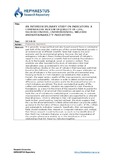| dc.description.abstract | It is generally recognised that indicator-based research forms a substantial part both of the everyday practice and of the current theoretical pursuits in an extensive set of different scientific fields that relate to the socio-economic and the environmental sphere. However, the lack of an endogenous indicator's theory hinders the enhancement of indicator's research into an autonomous scientific field and subdues the indicators study to the broader ecological, social, or economic context. Thus, scientists are often bounded to the study of indicators within their specialisation area, as evidenced by the very limited number of interdisciplinary studies on the use of indicators that have been published. Based on this deficiency of the current literature, the paper elaborates on the use of indicators in the socio-economic and the environmental area, focusing on fields in which indicators are essential to their practice. Namely, the paper reviews quality-of-life, macroeconomic, environmental, welfare and sustainability indicators in order to detect similarities and differences, pertain to their practice and to the theoretical frameworks in which indicators are utilised. The study concludes that quality-of-life, welfare and sustainability indicators are supported by weak theoretical foundations, as a result to the choice of the respective fields to exploit the possible benefits of an empirical interdisciplinary perspective, a fact that leads the use of indicators to methodological inconsistencies. In contrast, macroeconomic and environmental indicators are supported by a coherent theoretical body, which is reflected in their well-organised structure and leads to their sound practice. Last but not least, the study suggests that the way the aforementioned two fields utilise indicators can provide useful guidance to the formation of future objectives in the quality-of-life, welfare and sustainability indicators’ research. Specifically, their corresponding fields should moderate their interest on composite indicators and, instead, their future research should be focused, so much on the identification of their field's key indicators that play a crucial role to the interpretation of the complex phenomena studied, as on the identification of the relationships that link these key indicators together. | en_UK |


